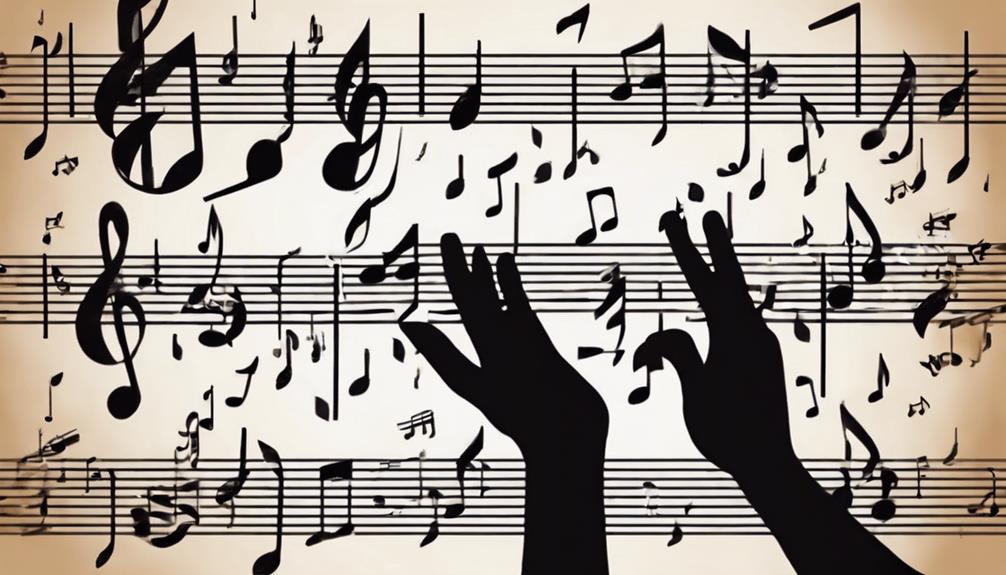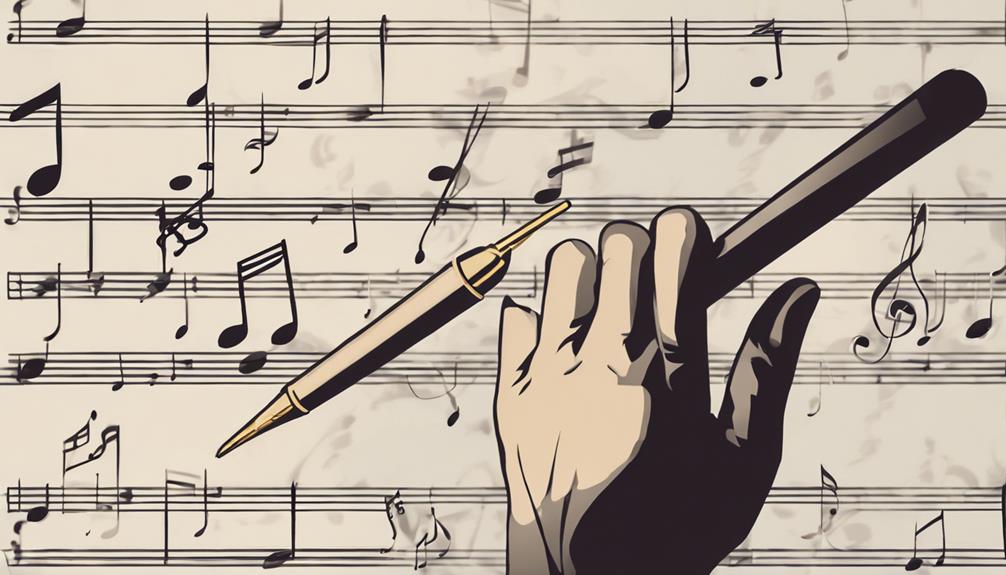No products in the cart.
Imagine you’re setting sail on the vast ocean of music creation, where chord progressions are the winds guiding your melody’s journey. As you embark on this adventure, you’ll find that mastering the ebb and flow of chords is essential to keeping your songs afloat and steering them toward uncharted territories of expression and emotion.
You’re not alone in this quest; every musician starts with a map of basic progressions and a compass pointing towards innovation. In the paragraphs ahead, you’ll uncover seven essential tips that will serve as your North Star, helping you navigate through the common pitfalls that snag many beginners.
These tips will not only clarify the foundational aspects of chord progressions but also empower you to infuse your music with a unique voice that resonates with listeners. So, let’s set the course for an expedition into the heart of songwriting, where your craft will grow, and your tunes will begin to truly sing.
Key Takeaways
- Understanding basic chords and chord progressions is essential for crafting music that resonates with listeners.
- Exploring key signatures and major scales enhances music reading skills and allows for innovation and creativity.
- Understanding minor keys and scales, as well as incorporating ear training exercises, helps solidify knowledge and analyze chord progressions.
- Starting with simple progressions and chord inversions allows for the mastery of basic chords and the ability to create diverse and nuanced sounds.
Understanding Basic Chords
Before diving into complex chord progressions, it’s crucial to grasp the fundamentals of basic chords, as they form the backbone of most songs you’ll want to play or write. Learning the theory behind these chords isn’t just academic—it’s a skill that can ignite your creativity in the songwriting process. While theory mightn’t come naturally to everyone, you don’t have to be a prodigy to make headway.
You can start by exploring resources tailored for beginners, like the ‘Beginning Songwriting’ book available on Amazon. It’s a practical way to familiarize yourself with chord construction and progression. Understanding basic chords is the first step in creating and experimenting with your own unique sound.
As you study, you’ll learn that exploring chord voicings can vastly expand your musical palette. You’ll see that the same chord can sound dramatically different depending on the voicing you choose. This knowledge is key to understanding chord progressions and how they can convey various emotions and dynamics in your compositions.
Exploring Key Signatures
To kickstart your chord progressions, it’s essential to grasp the major scales since they’re the foundation for understanding key signatures.
You’ll need to identify the relative minor keys as well, as they share the same key signature but start on a different note, offering a whole new mood.
This knowledge allows you to craft chord progressions with purpose and gives you the tools to modulate between emotions and energy levels in your compositions.
Understanding Major Scales
Grasping the concept of major scales and their key signatures is a fundamental step in navigating the diverse landscape of music theory. Major scales follow a pattern: whole, whole, half, whole, whole, whole, half. This sequence is the backbone for exploring melodic intervals and analyzing chord progressions in popular songs.
Your key signature acts as a map, guiding you to which notes are sharp or flat within a scale. Understanding this not only enhances your music reading skills but also equips you with the tools to innovate and create.
Dive into learning key signatures—it’s vital for playing in various keys and crafting chord progressions that resonate with listeners seeking freshness in music.
Identifying Minor Keys
Diving into minor keys, you’ll notice they create a different emotional texture compared to their major counterparts, primarily through their distinct key signatures and intervals. To master this, you’ll want to start with the basics: understanding the unique patterns of minor scales. By recognizing the key signatures and specific accidentals, you can identify minor keys with greater ease.
Incorporate ear training exercises and tools into your practice. Analyzing chord progressions in minor keys helps solidify your knowledge. Here’s a practical table to guide your exploration:
| Major Key | Relative Minor | Common Chord Progression |
|---|---|---|
| C Major | A Minor | i-iv-V |
| G Major | E Minor | i-VI-III-VII |
| D Major | B Minor | i-v-VII-III |
| A Major | F# Minor | i-VI-iv-V |
| E Major | C# Minor | i-iv-VI-V |
Starting With Simple Progressions

Kickstart your musical journey by mastering basic major and minor chords, the building blocks for crafting simple yet effective chord progressions. Understanding chord progressions in different genres is crucial, as it helps you to absorb the nuances that make each style unique.
For instance, the blues might rely heavily on the I-IV-V progression, while pop often uses the I-V-vi-IV pattern. Recognizing these frameworks will allow you to innovate within them and find your own sound.
Once you’re familiar with the fundamental chords, start experimenting with common progressions. The simplicity of I-IV-V is perfect for beginners, as it introduces you to the concept of movement within a key. This progression uses the tonic, dominant, and predominant chords, giving you a solid understanding of harmonic relationships.
Exploring different strumming patterns for simple progressions can further enhance your versatility. Whether you’re aiming for a gentle ballad or an upbeat anthem, the right strumming pattern can bring your music to life.
Use these simple progressions as a springboard to build more complex chord patterns and delve into the emotional impact they can have. With practice, you’ll soon create compelling music that resonates with listeners.
Experimenting With Chord Inversions
As you grow comfortable with basic chord progressions, it’s time to explore chord inversions to expand your sound.
Inversions can dramatically alter the texture of your music, offering a fresh take on familiar chords.
Exploring Inversion Varieties
To add depth and variation to your chord progressions, start by experimenting with different chord inversions such as root position, first inversion, and second inversion. Delving into inversions can unlock new creative potential in your songwriting.
Here’s how you can innovate your progressions:
- Diversify Your Sound: Utilize inversions to add a fresh perspective and avoid monotonous patterns.
- Smooth Transitions: Master techniques for seamless movement between chords using inversions.
- Emotional Nuance: Change the mood subtly by shifting the bass note with inversions.
- Complexity Without Overwhelm: Introduce richness to your music without complicating the structure excessively.
Incorporate these methods to leverage the benefits of using chord inversions in songwriting and to ensure your compositions stand out with sophistication and a unique edge.
Inversions Impact on Sound
Experimenting with chord inversions can transform your music’s texture, giving each progression a distinct character and mood. You’re not just playing chords; you’re exploring the emotional impact of chord inversions. They can elicit feelings, from subtle sadness to uplifting joy. By using chord inversions to create tension and resolution, you keep your listeners engaged, constantly on the edge of their seats.
| Chord Type | Emotional Impact |
|---|---|
| Root | Stability |
| 1st Inversion | Mild Tension |
| 2nd Inversion | Slight Unease |
| 3rd Inversion* | Dissonance |
(*if applicable)
Dive into these inversions to find a balance between the expected and the innovative. Each variation you try adds a layer of sophistication to your sound, setting you apart as a creator who dares to push boundaries.
Incorporating Rhythmic Variation


Shifting your strumming patterns can dramatically enhance the rhythmic appeal of your chord progressions. By creating rhythmic interest through strumming patterns and incorporating percussive techniques in chord progressions, you’ll bring a fresh, innovative sound to your music that keeps listeners engaged.
Here’s how to get started:
- Experiment with Strumming Patterns: Don’t stick to the same down-up strumming. Vary your patterns to introduce energy and complexity into your music.
- Embrace Syncopation: Play around with off-beat strumming to add groove. This can transform a simple progression into something that really swings.
- Try Different Time Signatures: Moving away from the common 4/4 time, try writing progressions in 3/4 or 6/8 to give your songs a unique rhythmic character.
- Percussive Techniques: Learn how to mute strings with your strumming hand to add a percussive element to your playing. This can be as simple as palm muting or as complex as integrated tap and slap techniques.
Don’t be afraid to mix and match these elements. You might start with a basic strumming pattern and gradually incorporate fingerstyle or arpeggios to diversify your rhythmic textures.
Adding Transitional Chords
Introducing transitional chords can bridge gaps between song sections, ensuring a smoother musical journey. As you delve into songwriting, you’ll find that these chords are pivotal in crafting a seamless flow. Don’t be afraid to experiment; transitional chords can add tension and anticipation, which propels your music forward.
Start by exploring chord substitutions. This involves swapping a chord in your progression with another that has a similar function. For instance, instead of going directly from a G to a C, try inserting an A minor7 between them. It’s subtle, yet it adds a new layer of sophistication.
Using borrowed chords is another innovative strategy. These are chords taken from a parallel key, which can create a surprising twist in your music. For example, if you’re in the key of C major, borrowing the Bb major chord from C minor can lead to an intriguing shift that captures your listener’s attention.
Strategically placed transitional chords make your progressions more dynamic. They can even facilitate a key change, adding depth to your song. Remember, the goal isn’t just to connect chords but to enhance the musical story you’re telling. Keep this in mind, and your transitions won’t just be smooth—they’ll be compelling.
Learning From Popular Songs


While exploring the nuances of chord substitutions and borrowed chords, take a cue from popular music to grasp how these concepts play out in songs that have captivated audiences worldwide. Analyzing chord progressions in these hits can provide a wealth of insight. Here’s how you can learn from them effectively:
- Identify Common Patterns: Listen to a variety of songs and try to recognize recurring progression patterns. This will help build your intuition for chord movement.
- Dissect Song Structures: Break down the sections of a song—verse, chorus, bridge—and note how the progression changes to enhance the story or mood.
- Experiment With Voicings: Applying chord voicings from your favorite tracks can add a fresh twist to your playing. Pay attention to how artists voice chords to create a signature sound.
- Understand Tension and Resolution: Notice how songs build tension with certain progressions and resolve it, teaching you the emotional impact of chord changes.
Use these steps as a springboard for innovation in your own music. By dissecting what’s worked in popular music, you can develop a deeper understanding and apply these principles to create something uniquely yours.
Frequently Asked Questions
How Do I Start Learning Chord Progressions?
You’ll start by diving into chord dictionaries to familiarize yourself with basic chords. Then, establish a practice routine to master them, progressively integrating more complex progressions to fuel your innovative musical journey.
What Is the 1 3 5 Rule for Chords?
The 1 3 5 rule for chords simplifies chord construction, using scale degrees to form harmonies. You’ll grab the first, third, and fifth notes from a scale to build your basic chords.
How Do I Get Better at Chord Progressions?
To get better at chord progressions, you’ll need to master various chord voicings and explore progression variations. Delve into music theory, practice consistently, and don’t be afraid to experiment with innovative combinations.
What Are the Fundamentals of Chord Progressions?
You’ll grasp chord progressions by mastering chord construction and exploring progression variety, which innovates beyond basic patterns to create fresh, appealing music that resonates with your unique artistic vision.
Conclusion
You’ve now got the tools to craft compelling chord progressions. Remember, understanding basics is your foundation.
Dare to explore new keys and inversions for variety. Keep rhythms fresh and use transitional chords to weave complexity.
Learn from hits, but inject your essence. Your progressions should reflect your unique musical voice.
Keep practicing, stay curious, and you’ll not only grow your chord vocabulary but also your confidence as a songwriter.
Now, go make some music!




